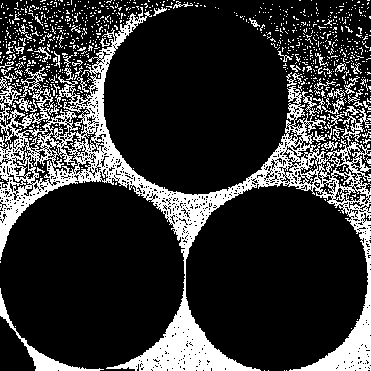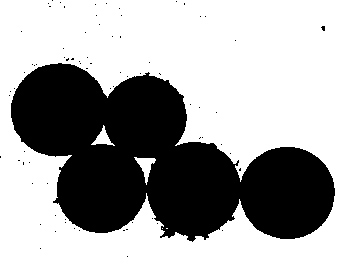Preparation method of monodisperse solvent-proof high-carboxyl-content polystyrene microsphere
A polystyrene microsphere, carboxyl content technology, applied in the field of soap-free emulsion polymerization, can solve the problems of increasing the amount of cross-linking agent, increasing the cost of cross-linked polystyrene microspheres, exhaust gas, etc., and achieve the effect of not being easy to swell and decompose
- Summary
- Abstract
- Description
- Claims
- Application Information
AI Technical Summary
Problems solved by technology
Method used
Image
Examples
Embodiment 1
[0018] The method for preparing monodisperse polystyrene microspheres in this embodiment comprises the following steps:
[0019] Add 2g styrene, 0.08g divinylbenzene, 0.01g vinyltriethoxysilane, 0.15g bisphenol A diallyl ether, 0.15g trihydroxypropane and 50ml deionized water into a 250mL three-necked flask, Stir at 300rpm, blow nitrogen for 30min while raising the temperature to 87°C, then add 0.1g diacetone acrylamide, 0.1g ethyl methacrylate and 0.1g tert-butyl methacrylate, 0.1g sodium bisulfite, and continue stirring for 5min. 20 mg of potassium persulfate was added to initiate polymerization. The stirring speed was maintained at 300rpm, and the reaction time was 12h.
[0020] Each of the cross-linked carboxypolystyrene microspheres prepared in Example 1 and the purchased cross-linked carboxypolystyrene microspheres took 1ml (solid content 10%) of the emulsion, after centrifugation, washed 3 times with ethanol, and dissolved in 100ml In the acetone solution, stir at roo...
Embodiment 2
[0026] The method for preparing monodisperse polystyrene microspheres in this embodiment comprises the following steps:
[0027] Add 3g styrene, 0.12g divinylbenzene, 0.03g vinyltriethoxysilane, 0.2g bisphenol A diallyl ether, 0.2g trihydroxypropane and 50ml deionized water into a 250mL three-necked flask, Stir at 300rpm, blow nitrogen for 30min while raising the temperature to 87°C, then add 0.2g diacetone acrylamide, 0.15g ethyl methacrylate, 0.15g tert-butyl methacrylate, 0.2g sodium bisulfite, and continue stirring for 5min. 20 mg of potassium persulfate was added to initiate polymerization, the stirring speed was maintained at 300 rpm, and the reaction time was 12 h.
Embodiment 3
[0029] The method for preparing monodisperse polystyrene microspheres in this embodiment comprises the following steps:
[0030] Add 4g styrene, 0.18g divinylbenzene, 0.035g vinyltriethoxysilane, 0.25g bisphenol A diallyl ether, 0.3g trihydroxypropane and 100ml deionized water into a 250mL three-necked flask, Stir at 300rpm, blow nitrogen for 30min while raising the temperature to 85°C, then add 0.25g diacetone acrylamide, 0.15g ethyl methacrylate and 0.15g tert-butyl methacrylate, 0.2g sodium bisulfite, and continue stirring for 5min. 20 mg of potassium persulfate was added to initiate polymerization, the stirring speed was maintained at 300 rpm, and the reaction time was 12 h.
PUM
 Login to View More
Login to View More Abstract
Description
Claims
Application Information
 Login to View More
Login to View More - R&D
- Intellectual Property
- Life Sciences
- Materials
- Tech Scout
- Unparalleled Data Quality
- Higher Quality Content
- 60% Fewer Hallucinations
Browse by: Latest US Patents, China's latest patents, Technical Efficacy Thesaurus, Application Domain, Technology Topic, Popular Technical Reports.
© 2025 PatSnap. All rights reserved.Legal|Privacy policy|Modern Slavery Act Transparency Statement|Sitemap|About US| Contact US: help@patsnap.com



